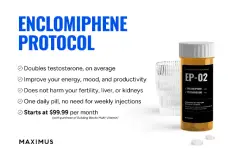madman
Super Moderator
* We demonstrate the clinical potential for intranasal kisspeptin delivery as the first non-invasive method to robustly and safely stimulate gonadotropins with kisspeptin and potentially transform the management of reproductive disorders.
* In summary, we provide the first human evidence identifying intranasal delivery as a novel, non-invasive, and well-tolerated route of kisspeptin administration to rapidly and robustly stimulate gonadotropin release. Furthermore, the demonstration that kisspeptin-54 in 0.9% saline solution remains within pharmaceutically accepted limits for stability for up to 60 days at 4 ◦C, provides a realistic opportunity to create a patient self administered nasal medicine that would be preferable to current invasive methods (injection) for patients and clinicians alike.

Summary
Background
Kisspeptin administration by intravenous or subcutaneous routes activates hypothalamic gonadotropinreleasing hormone (GnRH) neurons and is being developed to treat reproductive disorders. However, these invasive routes markedly limit patient acceptability and clinical use. Recent rodent data has identified a large GnRH population within the olfactory system communicating directly with hypothalamic GnRH neurons. Intranasal kisspeptin administration may be able to capitalise on this novel pathway and thus offer a potentialnon-invasive approach to stimulate reproductive hormones. Herein, we examine intranasal kisspeptin using human, pharmaceutical, and rodent studies.
Methods
Reproductive hormone profiles were measured after intranasal kisspeptin administration in healthy volunteers and patients with reproductive disorders as part of a randomised, double-blinded, crossover, placebo controlled clinical study. Pharmaceutical testing evaluated the chemical stability and nasal kisspeptin delivery, androdent studies provided mechanistic insight.
Findings
Intranasal kisspeptin-54 rapidly stimulates gonadotropin release in healthy men and women, and in patients with a common reproductive disorder (hypothalamic amenorrhoea), without any side effects or adverse events encountered. Specifically, intranasal kisspeptin (at 12.8 nmol/kg) induced clinically-significant mean maximal increases above baseline in serum luteinising hormone in all study groups: 4.4 ± 0.6 IU/L (mean difference = 3.1IU/L [95% CI, 1.2–4.9], P = 0.002 vs. placebo) in healthy men; 1.4 ± 0.3 IU/L (mean difference = 1.0 IU/L [95%CI, 0.4–1.7], P = 0.004 vs. placebo) in healthy women; 4.4 ± 0.2 IU/L (mean difference = 4.3 IU/L [95% CI,2.7–6.0], P < 0.001 vs. placebo) in patients with hypothalamic amenorrhoea. Kisspeptin-54 was delivered effectively via nasal spray and was stable for up to 60 days at 4 ◦C. Mirroring the human effects, intranasal kisspeptin-54 in adult C57BL/6J male mice stimulates luteinising hormone release. Further mechanistic insights reveal the accumulation of fluorescently-tagged kisspeptin in the olfactory epithelium, as well as the presence of kisspeptin receptors in olfactory bulb GnRH neurons, implicating the involvement of these extra-hypothalamic GnRH neurons in the pathway mediating intranasal kisspeptin’s effects on reproductive hormones.
Interpretation
We demonstrate the clinical potential for intranasal kisspeptin delivery as the first non-invasive method to robustly and safely stimulate gonadotropins with kisspeptin and potentially transform the management ofreproductive disorders.
Study protocol
This was a randomised, double-blinded, crossover, placebo-controlled clinical study (Figs. 1a, 2a and 3a). Participants were admitted to the Clinical Research Unit (Imperial College Healthcare NHS Trust) and completed five (in healthy men) or two (in healthy women and patients with HA) study visits. To ensure washout, study visits were at least 1 week apart inhealthy men and patients with HA, given that the circulating half-life of kisspeptin-54 is 27.6 min.54 Study visits in healthy women were conducted in the follicular phase of the menstrual cycle (i.e., days 2–10 inclusive) to control for changes in reproductive hormones over the course of the cycle and were conducted across two different menstrual cycles to allow washout.
All studies commenced at 08:00 to control for circadian hormonal changes. Participants were instructed to abstain from alcohol, caffeine, and sexual activities from 22:00 preceding each study visit. On arrival, an intravenous cannula was inserted into one antecubital fossa, and blood was sampled at timepoints −30, −15, and 0 min, before intranasal administration of kisspeptin-54 or 0.9% saline (placebo). Following participant education (described below), healthy men self-administered the following 5 interventions under supervision in random order via the intranasal route: 3.2, 6.4, 12.8, and 25.6 nmol/kg of kisspeptin-54, or placebo. Healthy women and patients with HA attended for the same protocol comparing12.8 nmol/kg of kisspeptin-54 and placebo in random order. After administration of kisspeptin-54 or placebo at timepoint 0 min, serum levels of LH, FSH, and testosterone (in men), or oestradiol and progesterone (in women) were measured every 15 min for 4 h. Heart rate, blood pressure, and the presence of adverse symptoms were recorded every 15 min.
There were no changes to the study (including eligibility criteria, protocol, or outcome measures) after study commencement and no interim analysis. Data collection, storage, and monitoring were conducted by the authors with use of an electronic password-protected data-capture system and backed-up daily onto the Imperial College London server. The database lock occurred once all participants had completed the study protocol (sample size described below).
Intranasal administration
Kisspeptin-54 or placebo was self-administered using nasal spray devices that delivered a single volume of 100 μL per actuation (SP270+ pump, 3959 actuator, 5 mL SGD U-Save glass bottles provided by Nemera, LaVerpillière, France). The kisspeptin-54 nasal spray solution formulations were prepared by reconstituting kisspeptin-54 powder stored in sterile vials on the morning of each study visit to produce a solution containing the target dose according to body weight in 400 μL.
Participants were familiarised with the procedure of intranasal application and were provided with written administration instructions ahead of each study visit, as described in.38 In addition, participants received a 5-mintraining session using a dummy nasal spray device before starting the study to ensure good technique, which all participants easily understood. Under instruction and supervision from the clinical team, participants primed the nasal sprays then self-administered a total of four sprays of kisspeptin-54 or placebo per visit (i.e., 4 × 100 μL), alternating between nostrils and leaving 60 s between sprays, to allow satisfactory dissipation and avoid solution running out of the nostrils. Nasal sprays containing kisspeptin or placebo were identical in appearance, volume, and administration technique.
Kisspeptin-54 peptide
Kisspeptin-54 was synthesised by Bachem (BachemHolding AG) and purified by reverse-phase high-performance liquid chromatography (HPLC). Sterile vials of kisspeptin-54 were produced by Bachem (Clinalfa,Bachem Distribution Services GmbH) according to Good Manufacturing Practice. Electrospray mass spectroscopy and amino acid analysis confirmed the identity of the peptide as previously described.54 The Limulusamoebocyte lysate assay (Associates of Cape Cod, Liverpool, UK, catalogue #T0051-25) was negative for endotoxin, and the peptide was sterile on culture (Department of Microbiology, Hammersmith Hospital, London). Vials of freeze-dried kisspeptin-54 were stored at −20 ◦C.
The kisspeptin doses selected were based on ourm previous data demonstrating robust LH rises following a single intravenous bolus of 6.4, 12.8, and 25.6 nmol/kg of kisspeptin-54 in healthy men, 59 as well as the addition of a lower dose of 3.2 nmol/kg given that administration of kisspeptin has until now not been investigated via the intranasal route in humans
Results
Effects of intranasal administration of kisspeptin in healthy men It is not known whether intranasal administration of kisspeptin stimulates reproductive hormone release. As such, we first conducted clinical studies in twelve healthy men (mean age 28.3 ± 1.7 years, BMI24.5 ± 0.7 kg/m2) as part of a randomised, double blinded, crossover, placebo-controlled study (Fig. 1a and Supplemental Fig. S1). A summary of baseline characteristics is provided in Table 1. Importantly, reproductive hormone levels were equivalent between study visits at baseline (Supplemental Table S1). Participants attended for five study visits each (with visits separated by one week) and received all the following five interventions, in random order, via the intranasal route: 3.2, 6.4, 12.8, and 25.6 nmol/kg of kisspeptin-54, or 0.9% saline (placebo). These doses were selecte dbased on previous studies in human volunteers where subcutaneous administration of these doses of kisspeptin-54 resulted in a significant LH rise.16, 59 After brief instructions, all participants self-administered intranasal kisspeptin-54 or placebo, followed by blood sampling for serum LH, FSH, and testosterone every15 min for 4 h.
Intranasal kisspeptin acutely stimulates gonadotropin releasein healthy men
Intranasal kisspeptin-54 administration to healthy men resulted in rapid clinically-significant and dose dependent increases in circulating LH levels, followed by sustained elevations throughout the sampling period,in comparison to placebo (6.4 nmol/kg vs. placebo mean difference = 1.3 IU/L [95% CI, 0.4–2.2], P = 0.006, two way ANOVA with Bonferroni correction; 12.8 nmol/kgvs. placebo mean difference = 2.5 IU/L [95% CI,1.5–3.5], P < 0.001, two-way ANOVA with Bonferronicorrection; 25.6 nmol/kg vs. placebo mean difference = 2.3 IU/L [95% CI, 1.2–3.4], P < 0.001, two-way ANOVA with Bonferroni correction). Peak stimulationof serum LH was observed 30–45 min after intranasal kisspeptin-54 administration (Fig. 1b). Correspondingly, the mean AUC increase in serum LH was elevated significantly compared to placebo, following all doses of kisspeptin-54: mean AUC increase (in h⋅IU/litre) 3.2 nmol/kg: 172.2 ± 64.2 (mean difference = 197.6[95% CI, 10.6–384.6], P = 0.037, one-way ANOVA with Bonferroni correction); 6.4 nmol/kg: 300.2 ± 79.2 (mean difference = 325.5 [95% CI, 122.6–528.4], P = 0.002, one way ANOVA with Bonferroni correction); 12.8 nmol/kg:595.7 ± 98.3 (mean difference = 621.1 [95% CI, 257.2–985.1], P = 0.001, one-way ANOVA with Bonferroni correction); 25.6 nmol/kg: 549.0 ± 108.6 (mean difference = 574.4 [95% CI, 353.7–795.1], P < 0.001, one way ANOVA with Bonferroni correction) (Fig. 1c and Supplemental Table S2). Similarly, the mean maximal increase in LH from baseline occurred in a dose dependent manner, with maximal stimulation of LH observed after kisspeptin-54 at 12.8 nmol/kg: 4.4 ± 0.6 IU/L above baseline (mean difference = 3.1 IU/L [95%CI, 1.2–4.9], P = 0.002 vs. placebo, one-way ANOVA with Bonferroni correction) (Fig. 1d and Supplemental Table S2).
Similar to LH, serum FSH levels were significantly elevated compared to placebo following intranasal kisspeptin-54 administration at doses 6.4 nmol/kg (mean difference = 0.4 IU/L [95% CI, 0.1–0.7], P = 0.005 vs. placebo, two-way ANOVA with Bonferroni correction) and 12.8 nmol/kg (mean difference = 0.6 IU/L [95% CI,0.3–0.9], P < 0.001 vs. placebo, two-way ANOVA with Bonferroni correction) (Fig. 1e). Maximal overall stimulation of FSH was observed after 12.8 nmol/kg, withme an AUC increase 96.3 ± 23.2 h⋅IU/litre (mean difference = 156.6 [95% CI, 14.2–299.0], P = 0.029 vs. placebo, one-way ANOVA with Bonferroni correction) (Fig. 1f and Supplemental Table S2) and peak FSH rise of 0.7 ± 0.2 IU/L above baseline (mean difference = 0.7 IU/L [95%CI, 0.1–1.3], P = 0.022 vs. placebo, one-way ANOVA with Bonferroni correction) (Fig. 1g and SupplementalTable S2).
Intranasal kisspeptin stimulates testosterone release in healthy men
Following intranasal kisspeptin-54 administration (12.8 nmol/kg), there was an increase in downstream testosterone (Fig. 1h). At this dose, serum levels of testosterone steadily increased to peak levels from 120 min (mean difference = 1.91 nmol/L [95% CI,0.26–3.55], P = 0.03, two-way ANOVA with Bonferroni correction) after administration, with this rise delayed compared to LH and FSH as expected for a downstream hormone. Following 12.8 nmol/kg, the mean AUC increase was 470.4 ± 144.0 h nmol/L (mean difference = 654.3 [95% CI, 224.6–1084.0], P = 0.003 vs .placebo, one-way ANOVA with Bonferroni correction) (Fig. 1i and Supplemental Table S2), with a clinically significant maximal increase of 4.9 ± 0.7 nmol/L above baseline at 150 min (mean difference = 2.4 nmol/L [95% CI, 0.4–4.4], P = 0.018 vs. placebo, one-way ANOVA with Bonferroni correction) (Fig. 1j and Supplemental Table S2).
* In summary, we provide the first human evidence identifying intranasal delivery as a novel, non-invasive, and well-tolerated route of kisspeptin administration to rapidly and robustly stimulate gonadotropin release. Furthermore, the demonstration that kisspeptin-54 in 0.9% saline solution remains within pharmaceutically accepted limits for stability for up to 60 days at 4 ◦C, provides a realistic opportunity to create a patient self administered nasal medicine that would be preferable to current invasive methods (injection) for patients and clinicians alike. To this end, our data support further evaluation of intranasal kisspeptin administration in larger-scale clinical studies.
* In summary, we provide the first human evidence identifying intranasal delivery as a novel, non-invasive, and well-tolerated route of kisspeptin administration to rapidly and robustly stimulate gonadotropin release. Furthermore, the demonstration that kisspeptin-54 in 0.9% saline solution remains within pharmaceutically accepted limits for stability for up to 60 days at 4 ◦C, provides a realistic opportunity to create a patient self administered nasal medicine that would be preferable to current invasive methods (injection) for patients and clinicians alike.
Summary
Background
Kisspeptin administration by intravenous or subcutaneous routes activates hypothalamic gonadotropinreleasing hormone (GnRH) neurons and is being developed to treat reproductive disorders. However, these invasive routes markedly limit patient acceptability and clinical use. Recent rodent data has identified a large GnRH population within the olfactory system communicating directly with hypothalamic GnRH neurons. Intranasal kisspeptin administration may be able to capitalise on this novel pathway and thus offer a potentialnon-invasive approach to stimulate reproductive hormones. Herein, we examine intranasal kisspeptin using human, pharmaceutical, and rodent studies.
Methods
Reproductive hormone profiles were measured after intranasal kisspeptin administration in healthy volunteers and patients with reproductive disorders as part of a randomised, double-blinded, crossover, placebo controlled clinical study. Pharmaceutical testing evaluated the chemical stability and nasal kisspeptin delivery, androdent studies provided mechanistic insight.
Findings
Intranasal kisspeptin-54 rapidly stimulates gonadotropin release in healthy men and women, and in patients with a common reproductive disorder (hypothalamic amenorrhoea), without any side effects or adverse events encountered. Specifically, intranasal kisspeptin (at 12.8 nmol/kg) induced clinically-significant mean maximal increases above baseline in serum luteinising hormone in all study groups: 4.4 ± 0.6 IU/L (mean difference = 3.1IU/L [95% CI, 1.2–4.9], P = 0.002 vs. placebo) in healthy men; 1.4 ± 0.3 IU/L (mean difference = 1.0 IU/L [95%CI, 0.4–1.7], P = 0.004 vs. placebo) in healthy women; 4.4 ± 0.2 IU/L (mean difference = 4.3 IU/L [95% CI,2.7–6.0], P < 0.001 vs. placebo) in patients with hypothalamic amenorrhoea. Kisspeptin-54 was delivered effectively via nasal spray and was stable for up to 60 days at 4 ◦C. Mirroring the human effects, intranasal kisspeptin-54 in adult C57BL/6J male mice stimulates luteinising hormone release. Further mechanistic insights reveal the accumulation of fluorescently-tagged kisspeptin in the olfactory epithelium, as well as the presence of kisspeptin receptors in olfactory bulb GnRH neurons, implicating the involvement of these extra-hypothalamic GnRH neurons in the pathway mediating intranasal kisspeptin’s effects on reproductive hormones.
Interpretation
We demonstrate the clinical potential for intranasal kisspeptin delivery as the first non-invasive method to robustly and safely stimulate gonadotropins with kisspeptin and potentially transform the management ofreproductive disorders.
Study protocol
This was a randomised, double-blinded, crossover, placebo-controlled clinical study (Figs. 1a, 2a and 3a). Participants were admitted to the Clinical Research Unit (Imperial College Healthcare NHS Trust) and completed five (in healthy men) or two (in healthy women and patients with HA) study visits. To ensure washout, study visits were at least 1 week apart inhealthy men and patients with HA, given that the circulating half-life of kisspeptin-54 is 27.6 min.54 Study visits in healthy women were conducted in the follicular phase of the menstrual cycle (i.e., days 2–10 inclusive) to control for changes in reproductive hormones over the course of the cycle and were conducted across two different menstrual cycles to allow washout.
All studies commenced at 08:00 to control for circadian hormonal changes. Participants were instructed to abstain from alcohol, caffeine, and sexual activities from 22:00 preceding each study visit. On arrival, an intravenous cannula was inserted into one antecubital fossa, and blood was sampled at timepoints −30, −15, and 0 min, before intranasal administration of kisspeptin-54 or 0.9% saline (placebo). Following participant education (described below), healthy men self-administered the following 5 interventions under supervision in random order via the intranasal route: 3.2, 6.4, 12.8, and 25.6 nmol/kg of kisspeptin-54, or placebo. Healthy women and patients with HA attended for the same protocol comparing12.8 nmol/kg of kisspeptin-54 and placebo in random order. After administration of kisspeptin-54 or placebo at timepoint 0 min, serum levels of LH, FSH, and testosterone (in men), or oestradiol and progesterone (in women) were measured every 15 min for 4 h. Heart rate, blood pressure, and the presence of adverse symptoms were recorded every 15 min.
There were no changes to the study (including eligibility criteria, protocol, or outcome measures) after study commencement and no interim analysis. Data collection, storage, and monitoring were conducted by the authors with use of an electronic password-protected data-capture system and backed-up daily onto the Imperial College London server. The database lock occurred once all participants had completed the study protocol (sample size described below).
Intranasal administration
Kisspeptin-54 or placebo was self-administered using nasal spray devices that delivered a single volume of 100 μL per actuation (SP270+ pump, 3959 actuator, 5 mL SGD U-Save glass bottles provided by Nemera, LaVerpillière, France). The kisspeptin-54 nasal spray solution formulations were prepared by reconstituting kisspeptin-54 powder stored in sterile vials on the morning of each study visit to produce a solution containing the target dose according to body weight in 400 μL.
Participants were familiarised with the procedure of intranasal application and were provided with written administration instructions ahead of each study visit, as described in.38 In addition, participants received a 5-mintraining session using a dummy nasal spray device before starting the study to ensure good technique, which all participants easily understood. Under instruction and supervision from the clinical team, participants primed the nasal sprays then self-administered a total of four sprays of kisspeptin-54 or placebo per visit (i.e., 4 × 100 μL), alternating between nostrils and leaving 60 s between sprays, to allow satisfactory dissipation and avoid solution running out of the nostrils. Nasal sprays containing kisspeptin or placebo were identical in appearance, volume, and administration technique.
Kisspeptin-54 peptide
Kisspeptin-54 was synthesised by Bachem (BachemHolding AG) and purified by reverse-phase high-performance liquid chromatography (HPLC). Sterile vials of kisspeptin-54 were produced by Bachem (Clinalfa,Bachem Distribution Services GmbH) according to Good Manufacturing Practice. Electrospray mass spectroscopy and amino acid analysis confirmed the identity of the peptide as previously described.54 The Limulusamoebocyte lysate assay (Associates of Cape Cod, Liverpool, UK, catalogue #T0051-25) was negative for endotoxin, and the peptide was sterile on culture (Department of Microbiology, Hammersmith Hospital, London). Vials of freeze-dried kisspeptin-54 were stored at −20 ◦C.
The kisspeptin doses selected were based on ourm previous data demonstrating robust LH rises following a single intravenous bolus of 6.4, 12.8, and 25.6 nmol/kg of kisspeptin-54 in healthy men, 59 as well as the addition of a lower dose of 3.2 nmol/kg given that administration of kisspeptin has until now not been investigated via the intranasal route in humans
Results
Effects of intranasal administration of kisspeptin in healthy men It is not known whether intranasal administration of kisspeptin stimulates reproductive hormone release. As such, we first conducted clinical studies in twelve healthy men (mean age 28.3 ± 1.7 years, BMI24.5 ± 0.7 kg/m2) as part of a randomised, double blinded, crossover, placebo-controlled study (Fig. 1a and Supplemental Fig. S1). A summary of baseline characteristics is provided in Table 1. Importantly, reproductive hormone levels were equivalent between study visits at baseline (Supplemental Table S1). Participants attended for five study visits each (with visits separated by one week) and received all the following five interventions, in random order, via the intranasal route: 3.2, 6.4, 12.8, and 25.6 nmol/kg of kisspeptin-54, or 0.9% saline (placebo). These doses were selecte dbased on previous studies in human volunteers where subcutaneous administration of these doses of kisspeptin-54 resulted in a significant LH rise.16, 59 After brief instructions, all participants self-administered intranasal kisspeptin-54 or placebo, followed by blood sampling for serum LH, FSH, and testosterone every15 min for 4 h.
Intranasal kisspeptin acutely stimulates gonadotropin releasein healthy men
Intranasal kisspeptin-54 administration to healthy men resulted in rapid clinically-significant and dose dependent increases in circulating LH levels, followed by sustained elevations throughout the sampling period,in comparison to placebo (6.4 nmol/kg vs. placebo mean difference = 1.3 IU/L [95% CI, 0.4–2.2], P = 0.006, two way ANOVA with Bonferroni correction; 12.8 nmol/kgvs. placebo mean difference = 2.5 IU/L [95% CI,1.5–3.5], P < 0.001, two-way ANOVA with Bonferronicorrection; 25.6 nmol/kg vs. placebo mean difference = 2.3 IU/L [95% CI, 1.2–3.4], P < 0.001, two-way ANOVA with Bonferroni correction). Peak stimulationof serum LH was observed 30–45 min after intranasal kisspeptin-54 administration (Fig. 1b). Correspondingly, the mean AUC increase in serum LH was elevated significantly compared to placebo, following all doses of kisspeptin-54: mean AUC increase (in h⋅IU/litre) 3.2 nmol/kg: 172.2 ± 64.2 (mean difference = 197.6[95% CI, 10.6–384.6], P = 0.037, one-way ANOVA with Bonferroni correction); 6.4 nmol/kg: 300.2 ± 79.2 (mean difference = 325.5 [95% CI, 122.6–528.4], P = 0.002, one way ANOVA with Bonferroni correction); 12.8 nmol/kg:595.7 ± 98.3 (mean difference = 621.1 [95% CI, 257.2–985.1], P = 0.001, one-way ANOVA with Bonferroni correction); 25.6 nmol/kg: 549.0 ± 108.6 (mean difference = 574.4 [95% CI, 353.7–795.1], P < 0.001, one way ANOVA with Bonferroni correction) (Fig. 1c and Supplemental Table S2). Similarly, the mean maximal increase in LH from baseline occurred in a dose dependent manner, with maximal stimulation of LH observed after kisspeptin-54 at 12.8 nmol/kg: 4.4 ± 0.6 IU/L above baseline (mean difference = 3.1 IU/L [95%CI, 1.2–4.9], P = 0.002 vs. placebo, one-way ANOVA with Bonferroni correction) (Fig. 1d and Supplemental Table S2).
Similar to LH, serum FSH levels were significantly elevated compared to placebo following intranasal kisspeptin-54 administration at doses 6.4 nmol/kg (mean difference = 0.4 IU/L [95% CI, 0.1–0.7], P = 0.005 vs. placebo, two-way ANOVA with Bonferroni correction) and 12.8 nmol/kg (mean difference = 0.6 IU/L [95% CI,0.3–0.9], P < 0.001 vs. placebo, two-way ANOVA with Bonferroni correction) (Fig. 1e). Maximal overall stimulation of FSH was observed after 12.8 nmol/kg, withme an AUC increase 96.3 ± 23.2 h⋅IU/litre (mean difference = 156.6 [95% CI, 14.2–299.0], P = 0.029 vs. placebo, one-way ANOVA with Bonferroni correction) (Fig. 1f and Supplemental Table S2) and peak FSH rise of 0.7 ± 0.2 IU/L above baseline (mean difference = 0.7 IU/L [95%CI, 0.1–1.3], P = 0.022 vs. placebo, one-way ANOVA with Bonferroni correction) (Fig. 1g and SupplementalTable S2).
Intranasal kisspeptin stimulates testosterone release in healthy men
Following intranasal kisspeptin-54 administration (12.8 nmol/kg), there was an increase in downstream testosterone (Fig. 1h). At this dose, serum levels of testosterone steadily increased to peak levels from 120 min (mean difference = 1.91 nmol/L [95% CI,0.26–3.55], P = 0.03, two-way ANOVA with Bonferroni correction) after administration, with this rise delayed compared to LH and FSH as expected for a downstream hormone. Following 12.8 nmol/kg, the mean AUC increase was 470.4 ± 144.0 h nmol/L (mean difference = 654.3 [95% CI, 224.6–1084.0], P = 0.003 vs .placebo, one-way ANOVA with Bonferroni correction) (Fig. 1i and Supplemental Table S2), with a clinically significant maximal increase of 4.9 ± 0.7 nmol/L above baseline at 150 min (mean difference = 2.4 nmol/L [95% CI, 0.4–4.4], P = 0.018 vs. placebo, one-way ANOVA with Bonferroni correction) (Fig. 1j and Supplemental Table S2).
* In summary, we provide the first human evidence identifying intranasal delivery as a novel, non-invasive, and well-tolerated route of kisspeptin administration to rapidly and robustly stimulate gonadotropin release. Furthermore, the demonstration that kisspeptin-54 in 0.9% saline solution remains within pharmaceutically accepted limits for stability for up to 60 days at 4 ◦C, provides a realistic opportunity to create a patient self administered nasal medicine that would be preferable to current invasive methods (injection) for patients and clinicians alike. To this end, our data support further evaluation of intranasal kisspeptin administration in larger-scale clinical studies.













